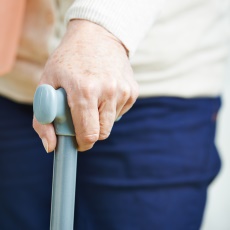
Preventing Falls
Falls can be dangerous at any age, but as you get older falling can present additional risks. Broken bones take longer to heal and may even lead to a loss of independence. Staying active and learning to improve your balance can help prevent falls.

National Institutes of Health
Other Languages
Falls can be dangerous at any age. Babies and young children can get hurt falling off furniture or down the stairs. Older children may fall off playground equipment. For older adults, falls can be especially serious. They are at higher risk of falling. They are also more likely to break a bone when they fall, especially if they have osteoporosis. A broken bone, especially when it is a hip, may even lead to disability and a loss of independence for older adults.
Some common causes of falls include
- Balance problems
- Some medicines, which can make you feel dizzy, confused, or slow
- Vision problems
- Alcohol, which can affect your balance and reflexes
- Muscle weakness, especially in your legs, which can make it harder for you to get up from a chair or keep your balance when walking on an uneven surface.
- Certain illnesses, such as low blood pressure, diabetes, and neuropathy
- Slow reflexes, which make it hard to keep your balance or move out of the way of a hazard
- Tripping or slipping due to loss of footing or traction
At any age, people can make changes to lower their risk of falling. It important to take care of your health, including getting regular eye exams. Regular exercise may lower your risk of falls by strengthening your muscles, improving your balance, and keeping your bones strong. And you can look for ways to make your house safer. For example, you can get rid of tripping hazards and make sure that you have rails on the stairs and in the bath. To reduce the chances of breaking a bone if you do fall, make sure that you get enough calcium and vitamin D.
NIH: National Institute on Aging
- Diagnosis and Tests: Evaluating a Fall or Risk of Falling (American Geriatrics Society)
- Fall Prevention: Simple Tips to Prevent Falls (Mayo Foundation for Medical Education and Research)
- How to Prevent Falls and Improve Your Balance
 (National Institute on Aging)
(National Institute on Aging) - Preventing Falls and Related Fractures
 (National Institute of Arthritis and Musculoskeletal and Skin Diseases)
(National Institute of Arthritis and Musculoskeletal and Skin Diseases)
- Keeping Your Balance (National Osteoporosis Foundation)
- Falls Among Older Adults: An Overview (Centers for Disease Control and Prevention)
- FastStats: Accidents or Unintentional Injuries (National Center for Health Statistics)
- ClinicalTrials.gov: Accidental Falls
 (National Institutes of Health)
(National Institutes of Health)
- National Institute on Aging
 Also in Spanish
Also in Spanish
- First Aid: Falls (Nemours Foundation)
- Balance Problems (American Geriatrics Society) - PDF
- Check for Safety: A Home Fall Prevention Checklist for Older Adults(Centers for Disease Control and Prevention) - PDF
- Falls Prevention: Unique to Older Adults (AGS Foundation for Health in Aging)
- After a fall in the hospital (Medical Encyclopedia)Also in Spanish
- Bathroom safety - adults (Medical Encyclopedia)Also in Spanish
- Exercises to help prevent falls (Medical Encyclopedia)Also in Spanish
- Preventing falls (Medical Encyclopedia)Also in Spanish






















.png)











No hay comentarios:
Publicar un comentario